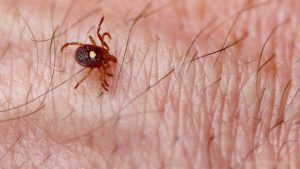
Colorado tick fever – causes, side effects and treatments at NaturalPedia.com
Saturday, February 17, 2018 by Janine Acero
http://www.naturalpedia.com/colorado-tick-fever-causes-side-effects-and-treatments-at-naturalpedia-com.html

The Colorado tick fever (CTF) is a virus that spreads to people through the bite of a wood tick (Dermacentor andersoni). According to the Centers for Disease Control and Prevention (CDC): “People who live in or visit areas in the western U.S. or western Canada that are 4,000 to 10,000 feet above sea level may be at risk of becoming infected.”
Most cases of CTF occur during spring and summer months when ticks are most active. Other names for the Colorado tick fever are mountain tick fever, American tick fever, and rocky mountain tick fever.

Known symptoms of Colorado tick fever
Tick-borne diseases such as CTF can cause flu-like symptoms, such as:
- Chills
- Severe headaches
- Sensitivity to light
- Muscle pain
- Skin tenderness and rashes
- Loss of appetite
- Nausea
- Vomiting
- Abdominal pain
- Weakness and fatigue
- Myocarditis
- Atypical pneumonia
- Hepatitis
- Pericarditis
- Orchitis
Infected children occasionally have hemorrhagic symptoms such as severe rash, gastrointestinal bleeding or disseminated intravascular coagulation. In addition, patients who are immunocompromised or who have undergone a splenectomy are at increased risk for severe complications.
Body systems harmed by Colorado tick fever
Most cases of CTF dissipate without treatment, but complications can still occur, including:
- Aseptic meningitis, an infection of the brain and spinal cord membranes
- Encephalitis, or swelling of the brain
- Hemorrhagic fever, which can affect multiple organs and damage blood vessels
Food items or nutrients that may prevent Colorado tick fever
There is currently no definitive treatment available for CTF, but there are natural options for managing and preventing tick bites. These include:
- Cinnamon oil – This is one of the most used natural repellents against ticks. Apply some cinnamon oil directly on the affected area, and on the rest of your skin for full protection.
- Orange – Squeeze out some fresh juice from one to two oranges and apply on the skin with the help of a cotton ball to soothe tick bites.
- Eucalyptus leaves/oil – For a highly effective insect spray, boil 15 to 20 eucalyptus leaves in one liter of water for ten minutes. Cool down the solution at room temperature before straining it in a spray bottle. Spray generously on your lawn to get rid of ticks and other insects. You can also use eucalyptus oil in place of leaves for this home remedy by adding ten drops of oil to four ounces of water. Shake well before use.
- Herbal insect repellents – Other effective herbal insect repellents include tea tree oil, calendula oil, and cedar oil. Tea tree oil and goldenseal oil also can be applied to affected parts of your skin to treat tick bites.
Treatment, management plans for Colorado tick fever
The best way to prevent tick-borne diseases is to avoid being bitten by ticks. For individuals who are planning to spend extended periods of time outside in endemic areas, the following precautions are appropriate:
-
Wear a long-sleeve shirt, and tuck the shirt into the pants
-
Tuck the pant legs into the socks
-
Wear light-colored clothing
- Wear a hat, tie back long hair
- Wear light-colored clothing so that a tick can be seen better
- Change clothes when you return from an area where ticks may be located
- Shower to wash off any loose ticks
-
Check clothing for ticks on a frequent basis
-
Apply insect repellents such as DEET or permethrin
Use fine-pointed tweezers to remove attached ticks. Follow these steps to make sure you remove the tick properly:
- The mouthparts of the tick are grasped with the tweezers as close to the skin as possible;
- Apply firm steady pressure upward until the tick releases – do not jerk, twist, squash or squeeze the tick;
- Clean the wound and the tweezers with an antiseptic; and
- Do not use petroleum jelly or nail polish remover, or prick or burn the tick, these actions can cause infected juices to enter the wound.
Where to learn more
- Repel ticks with this natural oil
- Antioxidants may protect against tick-borne illness (press release)
- Treat Lyme disease naturally without toxic antibiotic drugs
- The Versatile Herb Lavender Brings Many Benefits
- Top 6 Ways to Use Garlic as a Medicine
Summary
Colorado tick fever (CTF) is a virus that spreads to people who are bitten by infected ticks. Most cases of CTF occur during spring and summer months when ticks are most active.
There is currently no definitive treatment options for CTF.
Sources include:
Tagged Under: Tags: Colorado tick fever





